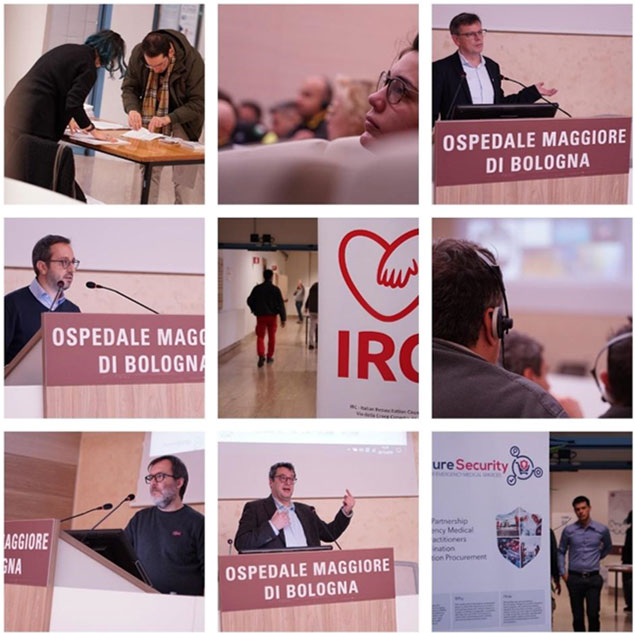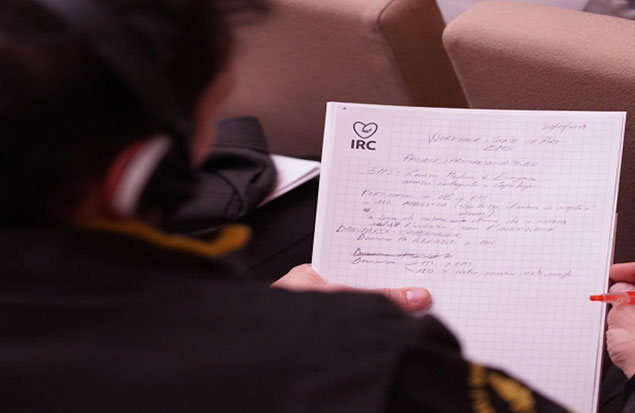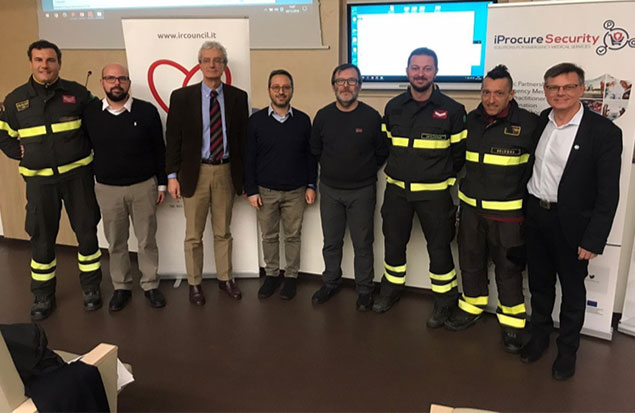30 November 2019, Bologna – Italy, State of Art of EMS
At the fourth workshop, “State of Art of EMS”, the EMS systems of Denmark, Switzerland and Italy were presented by the directors of the respective organizations. Topics of the discussion were the different EMS organizational structures, the response to emergencies in terms of timing, staff composition (doctors, nurses, paramedics, volunteers), available equipment (including number and type of vehicles) and innovative projects implemented in the three countries. Information was also presented on EMS financing (public or private), organization of work shifts and types of personnel working in the EMS. Furthermore, it was questioned whether the European emergency number 112 was more often used or preferred than other emergency numbers available. The type of triage in use, as well, pre-arrival instructions to bystanders close to the victims were also topics of discussion.
After the introduction of the different EMS organizations the president of IRC, presented the iProcureSecurity project. He continued with a report on the balanced combination of capabilities which the consortium partners represent with regard to research on a medical emergency, experience in the operation field, expertise in procurement and assessment of societal aspects. He then described the differences between Emergency Medical Services in Europe, such as funding, company management, emergency numbers, dispatch centers, types of rescue vehicles, staff composition etc. He concluded his presentation by pointing out the surveys on members of EMS management staff and EMS practitioners and their availability on iProcureSecurity project website.
The CEO of Pre-Hospital Services from Copenhagen and the region described the EMS system in Denmark. He started his presentation by asking the audience “What is the state of art of EMS systems? Are these EMS ambulances? Are they dispatch centers? State of the art, he continued, is a set of integrated systems”. The official from Denmark explained that EMS in Copenhagen is a public system with free access to healthcare to all citizens which provides information through GPs technology on all hospitals available. When a patient dials 112 he or she gets immediately transferred, depending on the event of emergency, to police, firefighter department or prehospital emergency team. The practitioners who manage the emergency calls hold the positions of paramedic and nurse. Additionally, there is a second emergency number that can be dialed -1813. This number is used in the events of deferred emergencies or by people who want to have a medical consultation. Both numbers management, 112 and 1813 are coordinated by the EMS. Copenhagen EMS receives approximately one million emergency calls per year. The calls which are transferred to 112 emergency dispatch are 350 thousand while 600 thousand are those managed by 1813 call center.
The member of the personal responsible for managing the 1813 emergency calls asks about the problem or needs of the caller. Within 2 hours the person is called back to see if his situation has improved or not. Based on assumption made by the 1813 personnel about the state of the caller she or he can also be sent to the hospital and put on a short waiting list. In this case, the patient’s health information is sent to the hospital as well as an SMS to the user to evaluate his satisfaction for the service provided. The operator of 112 number answers in 5 seconds while in case of, 1813 emergency call in up to 90 seconds. The dispatch centers managing both emergency call numbers communicate with each other. Thus they can monitor if the patient called both numbers or whether in the instance of a call to 1813 a medical emergency care is provided by general practitioners or the patient has been hospitalized.
Read more
Based on that system and referring to some key statistical data it was established that 75% of persons called 112 need an ambulance while the remaining 25% realized they do not need an ambulance or are consequently diverted to the GPs. Only 3% of 1813 callers received an ambulance.
The CEO of Pre-Hospital Services from Copenhagen continued with an elaboration on the types of ambulances used by the Danish EMS. There are ambulances and helicopters with doctors and nurses on board. There are also paramedical “Social ambulances” which respond to emergency events related to homeless people or people with mental disorders. There is also a dedicated neonatal service for emergencies involving small kids. He explained that there is a truck available equipped as a hospital and used for major incidents.
In Denmark, there is also an important AED network, with 20,000 AEDs around Copenhagen. Another project that is now running on a national level includes approximately 35,000 volunteer citizens, who can help as first responders in events of cardiac arrest. The presenter pointed out in this context that Artificial Intelligence (AI) solutions for cardiac arrest are also being implemented. The official from Denmark concluded his presentation by highlighting some key areas with potential for innovation, namely: patient-centered care, new technological equipment, more evidence-based practice and artificial intelligence.
The second speaker was the CEO of FTCSA, Ticino Cantonal Federation of Ambulance Services. He started with a description of the EMS system in Ticino, Switzerland by stating that EMS manages ambulances and REGA helicopters. Emergency Medical Services organizations are private institutions which handle the entire integrated system from the call (144) to patient discharge from the hospital. The dispatch operators manage all requests regarding the management of medical-health issues (pharmacy, home nurses, etc.) There are 81 vehicles, including ambulances with total 220 professional rescuers and 350 volunteers on board. The EMD protocol is used to handle the calls dialed through 144 emergency number with the intention to standardize the management of emergency calls and protect the staff from giving pre-arrival procedures. Each emergency call costs around 2 euros. The dispatch center answers within 10 seconds and within one minute the rescue crew is sent to the scene of emergency. The interventions are coded with a mixed system of colors. To increase the service level there are also rescuers who are on-call paid and can make themselves available any time.
The CEO of FTCSA explained that all ambulances are from type C (ALS ambulances). In the helicopter ambulance there are an emergency doctor and a rescuer. The personnel of the dispatch center have a medical background (nurse, rescuer) and extensive language skills (Italian, German, French, Spanish, and also dialect language). All dispatchers are authorized to deliver telephone-CPR. To work in the EMS system, the personnel should undergo a three years course. The costs which arise from the emergency health care provided to a patient are around 1300 francs (1200€).
On average, a minute and twenty-four seconds are needed to locate the patient and dispatch an ambulance. The ambulance team departures usually in less than 2 minutes and get in 90% of the cases within 12 minutes at the scene. The average treatment on-site lasts 34 minutes. All missions are followed and recorded in a dedicated database. Since 2014 an APP for first responders’ alert and AED localization has been also created. Additionally, a new public health project seeks to ensure that all 14-year-old citizens taking a first aid and CPR course.
The coordinator of the project Pronto Blu 118 for AUSL Bologna, described the EMS system in Italy. He recounted that Italy is the country with the oldest population in Europe, and life expectancy differs from region to a region. Healthcare is public and all citizens are offered free access to hospitals and EMS system. The budget comes from the state and it is then spread on regional level.
IRC report highlighted several aspects of the different dispatch centers in Italy showing that 55 centers still use the 118-emergency number and only 15 have implemented the European emergency number 112. Italy has numerous types of ambulances and emergency vehicles that are very different from one EMS to another, especially regarding the composition of the personnel on board. Like Denmark and Switzerland, in Italy there are a lot of emergency medical specialists who are involved in the EMS, as first responders: firefighters, police and in some instance (for example in Bologna) also cabs. The criteria to start telephone-CPR is heterogeneous on national level. In most cases when a dispatcher responds to an emergency call to provide a telephone CRP the victim does not respond or breathe. Finally, some dispatch centers ask for pulse detection. In the majority of cases, the call-taker is a nurse, but in some areas a technician. All the emergency dispatch centers in Italy suggest the caller to start CPR with chest compression only, without the two ventilations. Only 54% of dispatch centers authorize the use of an AED. Further on, the analysis carried out by IRC showed that AREU (EMS of Lombardy Region) uses an APP that allows localizing AEDs. Another APP, named DAE RespondER is integrated with three dispatch centers of Emilia Romagna Region and enables to localize personnel who can be hired as first-responders in case of cardiac arrest.
This workshop presented EMS systems from 3 different countries elaborating on the different emergency numbers, types of financial support, personnel and vehicles as well as applied technology. Based on the workshop’s findings one can state that apps for rescuers’ localization are implemented by all of the three analyzed EMS systems with the aim to engage the community to start CPR immediately prior to EMS arrival. Some of the EMS organizations have introduced and or are evaluating the application of artificial intelligence to support dispatch centers in the recognition of cardiac arrest. These tools seemed to perform better than humans and in future, they might be of great support not only in the diagnosis but also in the treatment of many other emergencies.
30 November 2019
Bologna – Italy




